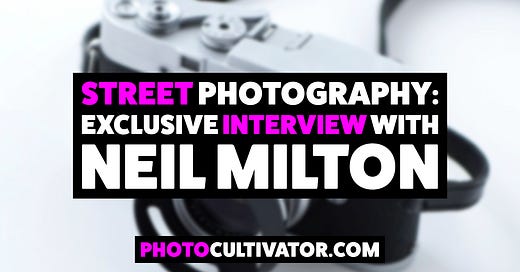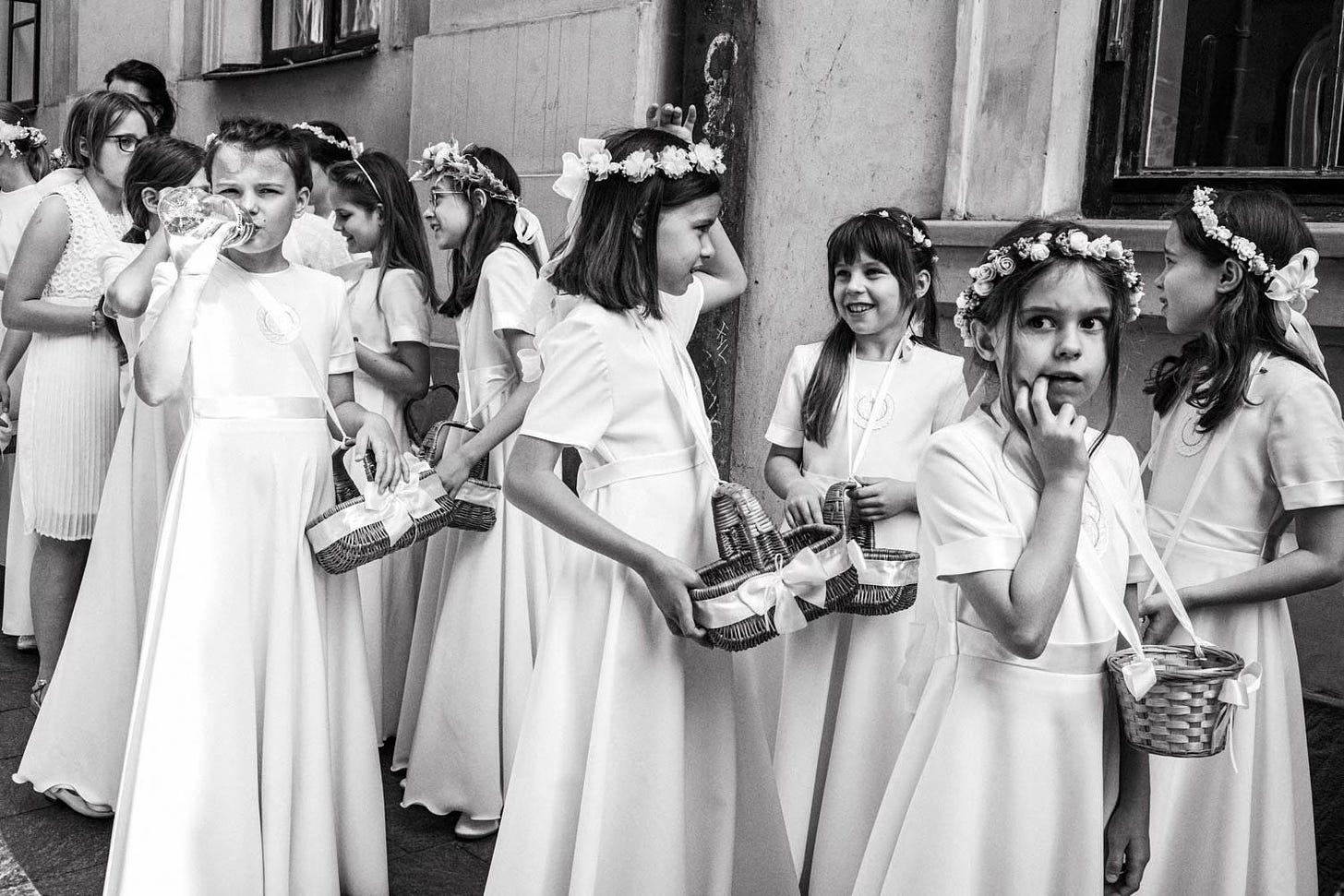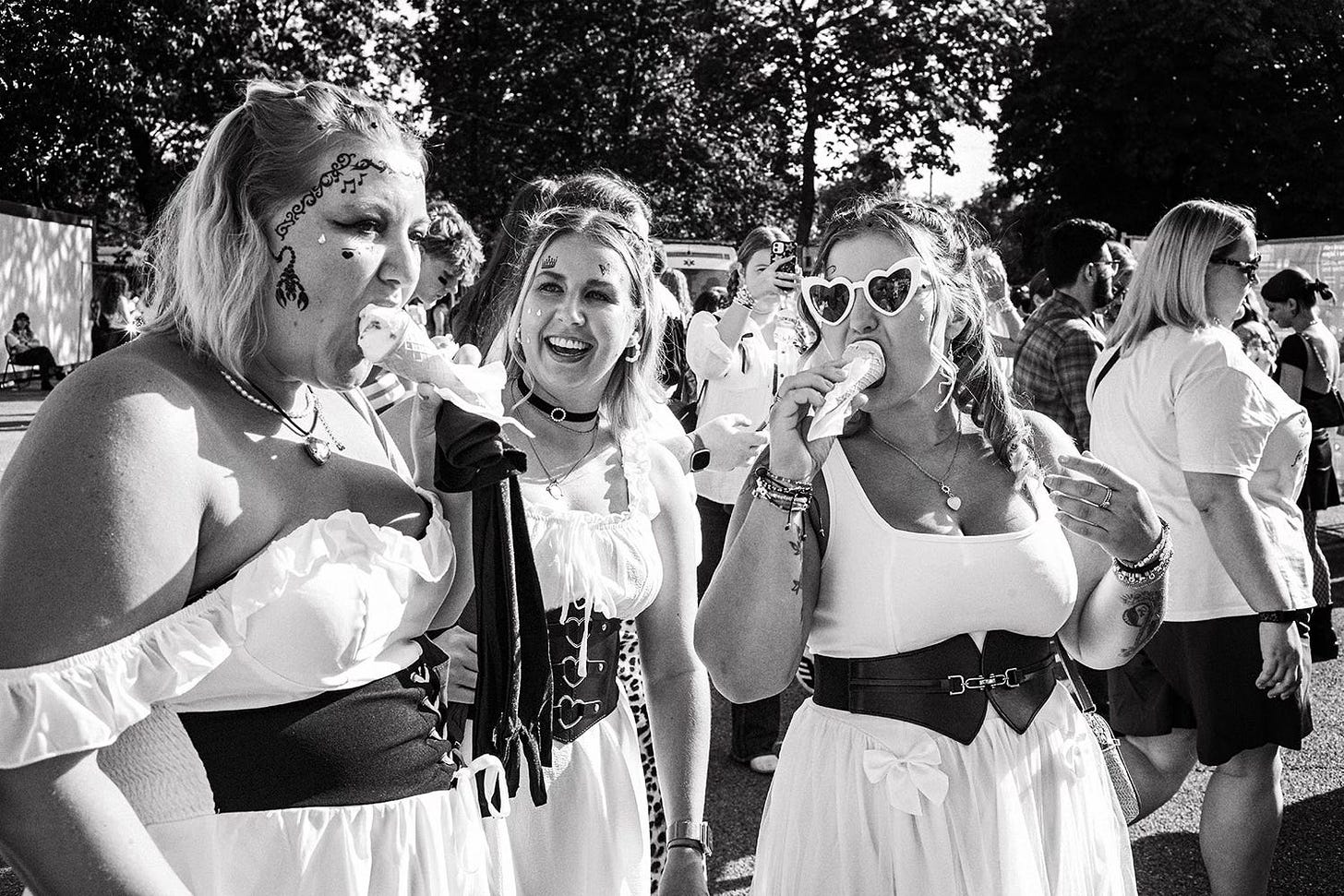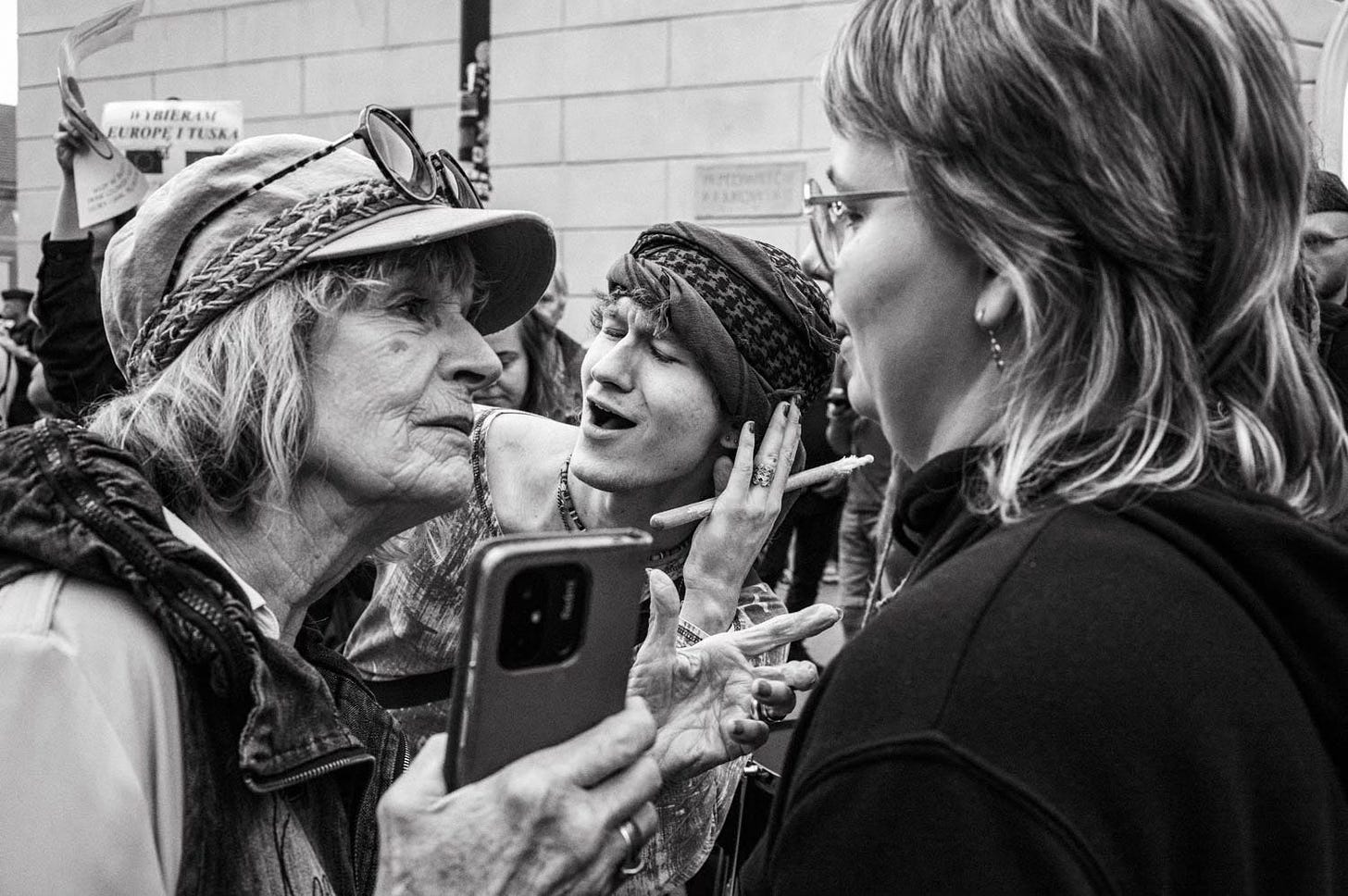As photographers, we always seek ways to improve our craft and get new perspectives.
Today, I’m excited to share an exclusive interview with Neil Milton, a talented street photographer based in Warsaw, Poland.
As a subscriber to Neil Milton's newsletter “Photos, mostly” and an admirer of his work, I was thrilled when he agreed to share his insights with our Photo Cultivator community!
Neil is a Scottish-born street photographer.
He has a unique eye for capturing everyday life's unexpected and unconventional moments.
Critics describe him as "a surrealist at heart with an eye for irony and amusing little moments".
His work has been featured in publications like The Guardian, Vanity Fair, and BBC.
His experience includes masterclasses with Magnum photographers Richard Kalvar and Bruce Gilden.
That makes him an invaluable source of knowledge for aspiring street photographers.
In this interview, Neil shares his journey, techniques, and insights into street photography.
Whether you're a beginner or a seasoned pro, I'm confident you'll find Neil's perspectives both inspiring and practical.
💡Photo Cultivator (PC): If you're new to photography, you might also want to check out my Ultimate Photography Guide for Beginners.
So here’s my conversation with Neil—I hope you’ll enjoy it as much as I did:
1. Neil, can you tell us about how you first got into photography?
As 2005 turned to 2006, I needed a rest from managing the independent record label I had owned since founding 5 years before.
I was deflated at a disappointing album release cycle and needed a break, so I arranged to put the label on hold.
I'm a person who always needs a project, so I picked up my mum's old compact digital Olympus and taught myself to make pictures.
Having just left the music industry, it seemed natural to start there so I began photographing concerts.
One thing led to another and within 6 months I'd gone from beginner, through several camera upgrades, through enthusiastic amateur, to my 1st paid gigs on Glasgow's music scene.
As many beginners do, I was experimenting.
What did I enjoy photographing?
I had no great interest in flowers, macro, landscapes, and nature, but I noticed a love for the challenge of street photography.
Early on, I was pretty bad at it but I kept plugging away until it usurped everything else and became what I'm known for, and what I loved most.
Some years later, and after a move to Warsaw in Poland, I was tempted back for almost a decade in the music industry.
The global pandemic finally put a full stop to the record label, and I took the opportunity to pick up a camera again and I got to work.
2. You recently transitioned from film to digital with the Leica M11-P. What motivated this change, and how has it impacted your street photography?
Since returning to photography, I'd been working with a Leica M6 and an M3 loaded with Tri-X.
When I began working for my agency this became untenable.
Most often, now I'll photograph a protest, demonstration, or other breaking news event.
And from the 1st press of the shutter release, it's a race against time, and other photographers, to get the photos up on the wire, so to speak.
For longer-term documentary work, I can still work on Tri-X and take my time, often leaving rolls of film for months before developing.
However, for agency work, there isn't time to develop, dry, scan, and process before getting the photos online.
The switch to a digital camera for street photography has yet to make a huge difference to the way I work as I'm still using a Leica M.
I still shoot manual exposure.
Most often with my street photography, I'm zone-focused as a default, and I find precise focusing when time allows.
The auto display of my LCD screen is switched off and I do my best not to chimp, though sometimes it's useful to steal a glance for peace of mind that I've got the shot before moving on.
The main difference is the unlimited number of frames available to me as I walk out the door.
I certainly shoot much more than I did previously, but I continue to try to do so with intention.
I've not been tempted down the spray-and-pray route, so far.
💡PC: Neil's transition from film to digital is a journey many photographers have experienced. If you're considering making the switch, my DSLR vs Mirrorless Cameras Guide might be helpful.
3. The 35mm Summicron f/2 has become your go-to lens. What makes this lens particularly suitable for your style of street photography?
Until earlier this year, I favored the 50mm, most recently the Summicron f/2.
The focal length felt natural and close to my own field of view.
With the M3 and its 50mm frame lines, it made sense to stick with it.
As my photography improved and my confidence grew, I began to find the 50mm a touch restrictive both in how close I could be to the scene, and in the depth of field available to me when zone focusing.
When I moved to digital for work, I tried the 35mm Summicron for a while with the feeling it would likely become my go-to, and that's what happened.
That was in March of this year, and I've taken the 50mm out with me only once or twice since then.
The 35mm is just a little wider than my natural field of view.
It gives me enough space to get in close to my subjects while allowing the picture to breathe around the edges.
It's been a bit of a revelation.
4. How would you describe your photography style? What themes or subjects do you find yourself drawn to most often?
I think of myself 1st and foremost as a street photographer.
That's not to say my photography comes only from pounding the pavement, though it often does.
Street photography though does inform the pictures I make whether at a demonstration, at a music show, or in the studio.
There are books, books, and books on what makes good street photography.
For me, I am looking for authentic, unposed, sincere expressions of emotion seen through either a glance, a gesture, connection, solitude, or often some juxtaposition of wry, ironic humor.
Richard Kalvar often talks about his frustration with street photographers whose frame would be the same if the photograph was made a second earlier or a second after.
I'm not always successful but I'm always aiming to make photos that could only have happened in that 1000th of a second when I tripped the shutter.
5. You've completed masterclasses with Magnum photographers like Richard Kalvar and Bruce Gilden. How have these experiences influenced your approach to capturing expressions and emotions in your subjects?
The Richard Kalvar Experience
The masterclasses were two of the strongest experiences I've had since picking up a camera.
While I understand the privilege I have that at that time in my life I could afford them and that not everyone can, I would recommend the experience to any photographer.
Richard Kalvar is one of my touchstone photographers.
So I was both delighted and a little anxious to attend this as my 1st masterclass, and at Magnum's Paris office, no less.
Richard is charming, funny, and deeply thoughtful about photography.
In music, I learned the phrase "you should never meet your heroes" can be somewhat inconsistent having both good and bad experiences.
Here, meeting Richard was a great experience.
The masterclass format was familiar:
Each participant presented a portfolio, then we enjoyed some teaching from Richard.
In the afternoon, the class is instructed to go out to photograph.
The next morning we present our new work to the class and Richard provides feedback.
Rinse and repeat.
It was a wonderful, if stressful experience.
As most street photographers know, whenever walking out the door, there's no guarantee of any opportunity to do good work.
I spent the 2nd afternoon having a less than productive time.
On a phone call to my partner, she made me see rationally that if all I was doing was impressing my idol then I wasn't benefitting from the masterclass.
Do the best I could do, then learn from his feedback - and rightly so.
Lessons Learned
I suppose the masterclass taught me the best strategies to analyze my failures and find where I could improve in the future.
Something I continue to do—being ruthless in my editing.
It was a great experience and I keep in touch, somewhat irregularly, with Richard to this day.
The Bruce Gilden Challenge
Bruce Gilden's reputation, of course, precedes him so there was an underlying anxiety as I arrived.
He's a lovely guy but brooks no bullshit.
He is happy to tell you that a photo is bad and exactly why he thinks so. He is not someone who holds back.
I was lucky enough to experience the milder side of Bruce but some of the feedback the others received was brutal.
He doesn't apologize for this approach, nor should he, and explains that if he were telling us only what we wanted to hear, we'd have wasted our money.
On Monday I was excited, on Wednesday I just wanted to go home, and on Friday all I wanted was another week of working with Bruce.
Bruce's masterclass was not street photography-specific and more about finding our photographic voice, so to speak.
At the beginning of the week, he asked each participant what we wanted to learn.
I felt confident enough in my candid street photography following Richard's masterclass in Paris, so I asked Bruce to help me in confidence to approach people for permission.
The Outcome
For that week, I made portraits of people on the streets of London with the instruction that I must stop them, ask them for permission, and interact with them in making the photograph.
By the end, I had a small portfolio of portraits, a heavy dose of confidence, and much admiration for Bruce.
Asking permission is not something I do often, but now I have that in my locker to bring it out should I need it.
6. As someone who teaches photography, what's the most important advice you give to aspiring street photographers?
Since the turn of the decade, I've been fascinated by the reaction of zoomers to candid street photography.
The scales fell from my eyes amid a conversation on the Street Photography subreddit on Reddit.
The overwhelming majority of young people nowadays find candid, unposed street photography, taken without consent, to be tantamount to abuse.
I don't share that opinion, of course, however, it has made me further analyze my own morals, ethics, and practice.
I say all this to preface the 1st piece of important advice I give to any young street photographers:
“Within the bounds of the law, every individual should draw their own ethical line.”
If a photographer doesn't feel it is appropriate to make candid photographs without permission, they shouldn't feel that they must.
On the other hand, if a photographer is comfortable making such photos, they should not feel any shame in doing so.
It's a much larger topic than to delve into here, but suffice it to say I have had many long, and at times controversial, conversations about it.
We've all heard Robert Capa's truism that if your photos aren't good enough, you're not close enough.
The 2nd piece of advice is well-worn and oft-said.
“Get closer. The most telling indication of an inexperienced street photographer is a photograph with small subjects, center frame, shot from across the road.”
If you want to make compelling, exciting street photography that will stop people in their tracks, you need to get in amongst the action.
Look at the pictures of Garry Winogrand, Robert Frank, Alex Webb, or Cartier-Bresson.
They are all visually very different but they all make the viewer feel like they are in the scene.
Before taking his famous trolley car photo, Robert Frank had been photographing a parade.
He turned, saw this perfect expression of race in 50s America, and took the photograph.
Lightning in a bottle. This is rarely the case.
Your favorite photographers took a lot of shit photographs.
No photographer gets it in camera 1st time, every time.
Browse through the contact sheets of the greats and you'll often see a process leading towards the final photograph you know and love.
A final piece of advice then:
“Accept this. You will make a lot of terrible photographs in between the great work.”
💡PC: Neil's approach to street photography is fascinating. If you're looking to improve your own street photography skills, my article on How to Overcome Fear of Street Photography might be useful.
For more tips on improving your craft, check out my 14 Essential Tips to Master Your Photography.
7. Can you share a memorable moment or interaction you've had while photographing on the streets of Warsaw?
I fought with a nun.
After the parade on Corpus Christi this year, I happened upon a group of nuns walking over a zebra crossing.
Ok, if you do what I do, and you're not thinking of taking that photograph, can you even call yourself a street photographer?
So I ran up, took a couple of pretty rubbish frames, to be honest, and then noticed a rather furious nun storming towards me.
No photo! No Photo!
She followed me down the street demanding that I delete the photograph, a request I politely but firmly declined.
This refusal was met with an astonishing request that I pay her 60 Euros.
At this point, things had become somewhat heated and I suggested that historically, this was probably an apt request for the catholic church before walking away, indignant.
My failure here was not refusing to delete the photo.
My failure was allowing myself to get further drawn into the argument.
As I tell my students, the best resolution to confrontation is to offer a sincere smile, an apology if necessary, thanks if not, and walk away.
Confrontations make for good stories, but they often give the fear to younger, more inexperienced photographers so it's important to say they come few and far between.
Most interactions, people are either perplexed or pleasant.
One memorable moment was in March 2022.
Refugees from Russia's invasion of Ukraine were coming to Warsaw on trains in their thousands and the major train stations were overwhelmed as temporary refugee centers.
I spent time there photographing.
One afternoon, I turned a corner to see a lady with her small dog. The dog was clad in a full Adidas doggy tracksuit.
I took a couple of frames working my way closer to the lady and for a brief moment, the dog stood up straight, on its wee hind legs, and put its front paws on the lady's suitcase.
Click.
I smiled at the lady, thanked her in Ukrainian, and moved on.
A couple of days later, I was at the train station again and saw the lady. Though she didn't speak English, and the only Ukrainian and Russian I knew was on a small card in my pocket to help me ask if I may photograph if it seemed appropriate, I approached her.
I showed her my phone with the freshly developed and scanned photograph of her dog.
She was delighted. I wanted to ask her if she might still be there the next day, as I would have made a print for her, but I was too shy.
I was worried with the language barrier it might seem that I was trying to sell her something, at what may have been one of the most difficult times in her life, so I opted not to.
I regret that.
Nevertheless, it was a lovely moment in a dark, upsetting few weeks.
8. How do you balance being "invisible" as a street photographer with the need to sometimes make eye contact or interact with your subjects?
It's certainly my preference to be invisible on the street, and I've become adept at it.
There was a time, early on, when through shyness, embarrassment, and a timid fear of confrontation, I would try to make my photographs without ever being seen.
I make photographs without seeking permission generally to photograph honest, sincere moments.
Eye contact, then was anathema to me, in much the same way that actors on TV don't look straight down the barrel during a take.
It was during the Kalvar masterclass though that we spoke at length about eye contact and it solidified a belief that, with confidence and skill, had been growing in me for a couple of years.
“In candid street photography, eye contact can make a dull photograph great and, if made in good time, doesn't need to diminish the veracity of the moment.”
Certainly, if one endeavours to get as close to a scene as I do, there is the risk of being noticed.
One just needs to have the confidence, or courage, to wait for that eye contact before tripping the shutter, and be able to express sincerity in why the shot was made if questioned afterward.
That was something I worked on for some time and even today, I still bottle it, but far less than I used to.
As a result, my photography is much better.
9. You're described as a "surrealist at heart with an eye for irony and amusing little moments." How do you cultivate this perspective in your work?
Hah! Yes, this was from a review of my 1st exhibition in Poland.
It was certainly flattering.
I love Breton, Aragon, Soupault, and I guess their antecedent, Lautréamont.
Whenever I'm home in Scotland and through in Edinburgh, I go to Modern One, the art gallery home to the biggest collection of Surrealist art in Europe.
My love of surrealism can come across in my photographs but I wouldn't describe my work as visually surrealist but maybe in practice.
Cartier-Bresson often recognized André Breton for teaching him to search the rubble of his subconscious in his work.
Much in the way that the surrealists would clear their minds and let the subconscious take over in their "automatic writing", street photographers have to be open and free to notice.
And to that degree, I feel my practice has a surreal bent.
Richard Kalvar uses the French word "disponible" to describe this necessary state of mind for taking good pictures.
Why do I choose to see certain things and disregard others?
Why did I choose to trip the shutter now rather than a few seconds later? One might argue it is a semi-automatic, intuitive, surrealist practice.
10. As both a photographer and writer, how do you feel these two forms of expression complement each other in your work?
I write about photography both in an academic and instructive way.
Also in a critical way.
To that extent, I suppose they complement each other, but not in any creative way.
I don't, for instance, compose the written word the way I might a rectangle.
I don't see my photography or my writing like that. That being said, I do like to write about photography and it forces me to think critically about my work, that of others, and my practice.
I can say, though, that I used to play music with bands for many years and it has surprised me how so many of the people I knew who were once musicians, when they finished up, moved on to photography.
There must be something complementary between those two things though specifically what, I don't know.
💡PC: Capturing authentic expressions is key in street photography. For more tips on capturing genuine moments, see my Event Photography Tips.
11. Outside of photography, what other hobbies or social activities do you enjoy?
Almost all of my life outside of photography has been in the music industry in one way or another.
I have played in several bands with varied success, and I owned and managed an independent record label for 20 years.
Though I don't play much, if ever, anymore, and the record label has been put to bed, I'm still a huge music nerd and a vinyl collector.
I'm also a big football fan supporting Airdrieonians in the Scottish Championship, and Newcastle United in the Premier League.
Despite being in Poland for 15 years I haven't adopted a Polish team, though I have started going to watch Hutnik Warszawa, a small club in the Polish 5th tier.
I'm far from a lucky mascot, they've lost both matches I've attended and won both that I have not.
Ouch.
Finally, I'm not really a big video game guy but I have a PS5 and am a big fan of Hideo Kojima games, with 2019's Death Stranding being my all-time favorite.
DS2 is out next year and I can't wait!
12. What's next for you in terms of projects or goals in your photography career?
Since the week of 7th October last year, I've been following the pro-Palestinian demonstrations in Warsaw and when Warsaw University students made an encampment, I began to focus on their protest.
With the new semester beginning, I'll be working more on this project while also beginning a couple of others.
I don't like to talk about them until they're underway but I'm excited about both.
Other than that, as we move into Autumn and the hot weather subsides, it will be easier to get back out onto the street for longer than a few hours at a time.
And, of course, I'm returning after some hiatus, to my street photography newsletter, Photos, mostly, so I'll get back to writing.
So, I'm looking forward to all of that.
13. Finally, what recommendations would you give to photography enthusiasts, from beginners to pros, who want to improve their craft?
Have your camera on your shoulder, wherever you go. It'll do no good for you nestled in the bottom of a bag.
If you're a budding street photographer learn how to zone focus.
Buy photo books.
“Look at as much photography as you can get your eyes on.”
My recommendations are:
Robert Frank's The Americans,
Richard Kalvar's Earthlings,
Cartier-Bresson's Scrapbook,
and Geoff Dyer's excellent The Street Philosophy of Garry Winogrand.
If you're into color photography, Martin Parr's The Last Resort and Alex Webb's retrospective The Suffering of Light are excellent.
Watch movies like James Nachtwey's War Photographer, Elliott Erwitt's Silence Sounds Good, Garry Winogrand's All Things Are Photographable, and Robert Frank's Leaving Home, Coming Home.
There is a great YouTube series by Josh Ethan Johnson called Wrong Side of the Lens which is worth finding too.
And... Get closer.
💡PC: If you're looking for more resources to improve your photography, take a look at my Best Photography Courses and Books for Beginners.
And That’s It
I hope you found Neil's insights as inspiring and informative as I did.
His emphasis on practice, observation, and developing one's own style resonates with my philosophy here at Photo Cultivator.
What aspects of Neil's advice resonate most with you?
I'd love to hear about your own street photography experiences or any questions you have for Neil.
Share your thoughts in the comments below!
For more of Neil's captivating work, visit his website at https://neilmilton.scot/.
And follow his newsletter for regular updates on his street photography journey.
💡PC: If you're interested in exploring more perspectives from accomplished photographers, don't miss my article on Famous Photographers Throughout History.
-Hakan
Founder, The Photo Cultivator Newsletter







